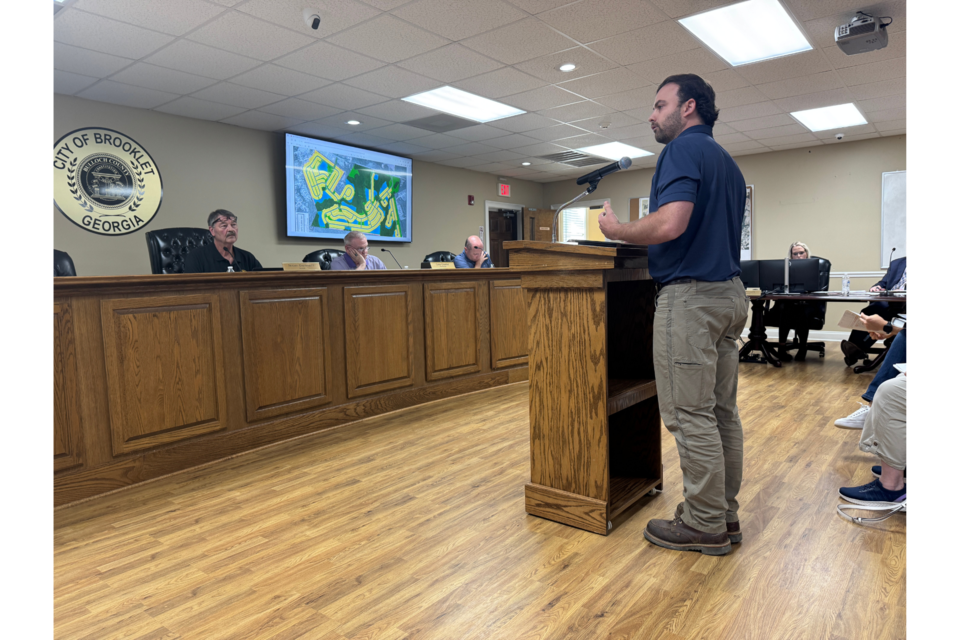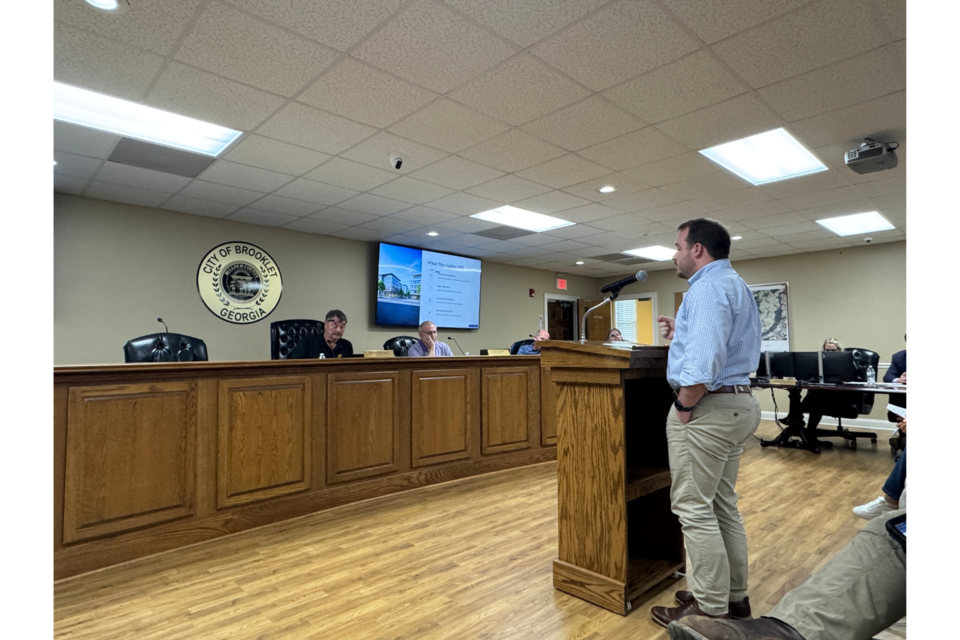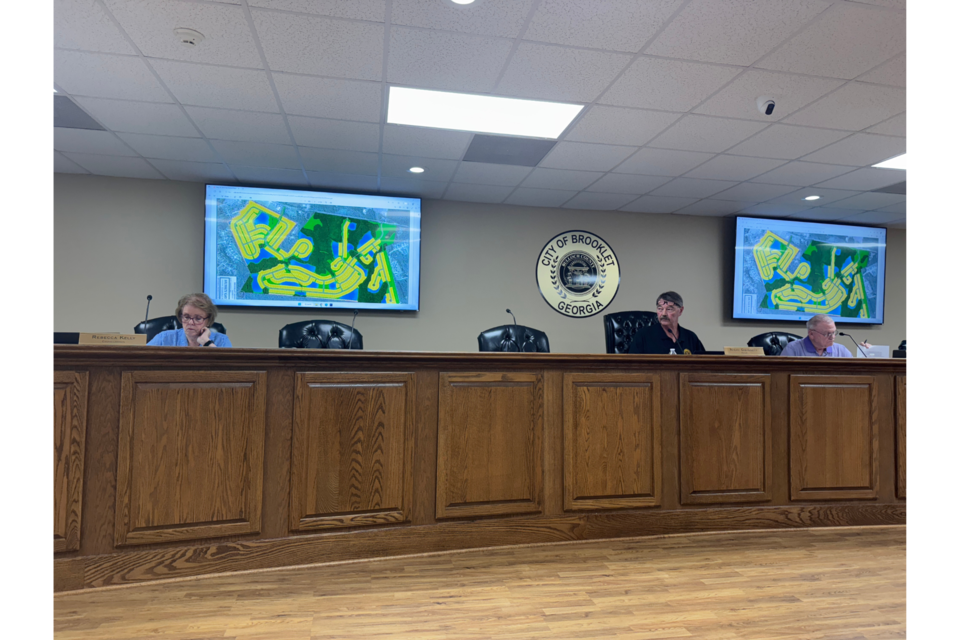On the evening of Thursday, May 15, 2025, the City of Brooklet convened a Work Session at 6:30pm, followed directly by the regularly scheduled City Council Meeting at 7:00pm. These meetings addressed several key issues facing the city, including proposed development, zoning ordinance updates, and other municipal business.
The Work Session was primarily dedicated to a detailed discussion regarding a proposal from WATERFORD INVESTMENTS HOLDINGS INC. Haydon Rollins of Hussey Gay Bell, representing the developer, presented to the council a plan that would necessitate revisions to the existing R-3 Subdivision ordinance. Rollins explained that the developer intended to combine two adjacent tracts of land, specifically Parcel # 136 000022 000 and 136 000024 001, into a unified subdivision. This consolidation was aimed at achieving greater infrastructure efficiency.
However, subsequent planning efforts brought to light the presence of more extensive wetland areas on the combined property than initially anticipated. This discovery posed a challenge to the developer's initial plans to construct 728 residential lots. Rollins emphasized the importance of reaching the 728-lot target, not only for the developer's financial viability but also for the City of Brooklet's revenue stream through sewer infrastructure payback and future tax revenue.
He warned that adhering to the current ordinance would result in approximately 100 fewer lots, translating to a potential loss of nearly $1 million in tap fees for the city, in addition to reduced future tax revenue from the residences.
To navigate these challenges, Rollins introduced the concept of "bonus incentive" options designed to encourage developers to incorporate certain amenities or meet specific public policy objectives in exchange for allowances to reduce lot sizes. He clarified that the specific incentives could be tailored to align with Brooklet's particular preferences and goals.
The layout presented to the council illustrated the proposed development on approximately 392 acres, with a significant portion, roughly 106 acres, designated as wetlands. Rollins indicated that only about half of the total acreage would be dedicated to residential lots and roads, with the remaining land reserved for open space, stormwater detention, or tree preservation areas.

Rollins provided examples of potential bonus incentives, including the provision of electric vehicle charging stations, open space, pedestrian sidewalk systems, recreational facilities (such as jogging trails, clubhouses, or swimming pools), public use sites for essential facilities, and public pedestrian plazas. He specified that the maximum lot size reduction allowed through these incentives would be capped at 30% for both lot width and lot square footage.
A key point of discussion arose regarding the timing of amenity development. Rollins explained that while a "master amenity" featuring a large swimming pool, playgrounds, and a clubhouse was planned for the development, it would likely be constructed between phases two and four of the project. He cited the substantial cost of such an amenity, estimated to be between $1 million and $2 million, and the need to achieve a sufficient number of lots sold to finance it.
Council members raised concerns about ensuring the completion of promised amenities, prompting Rollins to acknowledge the inherent risks in residential development while emphasizing the developer's significant investment and commitment to the project's success.
Additional discussion covered the range of house sizes planned for the development, which would likely span from approximately 1,700 to 3,500 square feet. The issue of minimum lot sizes was also addressed, with Rollins indicating that the developer was aiming for a minimum lot width of 60 feet. He provided context by comparing Brooklet's regulations to those of Bulloch County and Statesboro, noting the trend towards smaller lot sizes in newer developments, particularly those with access to water and sewer services.
Following the thorough presentation and discussion, a motion was made and carried to close the Work Session and proceed to the City Council Meeting.
The City Council Meeting officially commenced with Mayor Gwinnett calling the session to order, followed by an invocation and the Pledge of Allegiance. The council then moved to approve the meeting agenda.
A significant portion of the meeting involved the recognition of citizens who were present to address the council.
Mr. Gilbert Howard, a Brooklet resident, was the first to speak. He voiced his concerns about how Brooklet would accommodate the vehicles that will arrive with over 700 houses being built. He also raised the concern as to who would monitor the amenities, such as a park and a playground, that were proposed.
Aaron Carpenter, the Planning & Assistant Executive Director with the Coastal Regional Commission, presented a proposal for rewriting the city's zoning ordinances. Carpenter emphasized the necessity of this update due to several factors, including the outdated framework of the current ordinances, inadequate zoning districts, misalignment with the city's comprehensive plan, growth pressures, and the need for a more proactive and defensible regulatory framework.
He outlined the anticipated outcomes of the zoning rewrite, such as modernized regulations, improved alignment of zoning districts and land development rules with the city's vision and comprehensive plan goals, enhanced development quality, clear design and performance standards, and more efficient review processes for both staff and applicants. Carpenter also detailed the project team and process, timeline, estimated budget and effort, and the request for council action, which included approving the proposal, developing an agreement, and establishing a detailed scope and cost estimate to position Brooklet for smart, high-quality growth.

The council proceeded to address other items on the agenda, including the consideration and approval of minutes from previous meetings (February 20, 2025, and April 17, 2025, City Council Meetings) and the approval of the April Financial Reports.
Reports were then heard from various city officials and representatives, including the City Manager (Carter Crawford), Committee Members, City Clerk (Lori Phillips), Planning & Zoning Administrator (Melissa Pevey), Chief of Police (Michelle Reolegio), and City Engineer (Wesley Parker of Parker Engineering, LLC).
The meeting moved into discussion items, where the council took action on several key issues. Notably, they approved the proposal from the Coastal Regional Commission for rewriting the zoning ordinances, signifying a commitment to updating the city's land development regulations. The FY June 30, 2024, Audit, submitted by Reddick, Riggs, Hunter, and Colson, P.C., Certified Public Accountants, was also approved.
Furthermore, the council approved a resolution amending the fiscal year ending June 30, 2025, budget. The first reading of Ordinance No. 2025-0515, which pertains to amending Chapter 26 of the Code of Ordinances to establish penalties for delinquent payment of ad valorem taxes, was conducted. Finally, the council approved June 9, 2025 at 6:00 PM to facilitate public review of the recommended budget for the upcoming fiscal year 2026.

The meeting concluded with a motion to adjourn, which was duly carried.
For more information about the Brooklet City Council, please visit their website.




